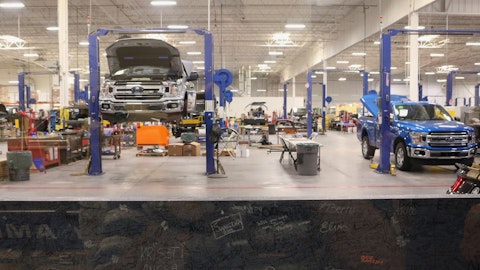Our technology in the Abrams is a 40-plus year platform at this point, many advances over time, but the differentiation there beyond the capability to deliver a highly reliable solution does come down to the – as well incumbency and the installed base there when you think about what’s been accumulated from an experience standpoint. And also the assets that are deployed for those particular cross-drive solutions. It can be a very capital-intensive process and one that requires a fairly high level of technical skill, both on the engineering side as well as manufacturing. So, when you think about that type of product, which is typically by on-highway measure, relatively low volumes, it does have a number of challenges when you think about sustaining a low level of very complex production over a period of time.
And that goes whether we are fabricating or supplier partners. But it’s fairly complex to actually launch propulsion solutions into that particular market. I would also add that the other differentiator for us is our team, which we have a global organization that we are able to cross-functionally leverage, whether that be technical sales, marketing, service channel, et cetera, but our reach is really critical when you think about deploying systems and the need to be able to service those on a global basis in a timely fashion.
Ian Zaffino: Okay. Thank you very much.
Operator: Thank you. Our next question comes from the line of Tim Thein with Citi. Please proceed with your question.
Tim Thein: Great. Thank you. And good afternoon. Dave or Fred, the question is really on the North America On-Highway segment. And just curious as to – if you look at the forecast from some or, I guess, the one independent consultancy out there. They’re calling, especially in the Class 8 market – sorry, the Class 8 straight truck market, a pretty significant step down in the fourth quarter. And I’m just curious, and this would extend to a lesser extent, the medium duty as well. But I’m just curious, as you – is that the messaging you’re getting from your OEM customers? And then B) I’m curious, is your guidance, that you just laid out today, does that assume that kind of follows that pattern of what ACT is assuming in terms of that sequential step down in the fourth quarter or is it something different?
Because it seems to be the messaging from certain of your OEM customers seems to be more not that falloff. So basically, the spirit of the question is what your guidance assumes? Is it that falloff or not? Thank you.
David Graziosi: Tim, it’s Dave. Good afternoon. So, I would just – you mentioned the forecaster I would tell you, as we things see things developing right now and the feedback that we have from our OEM partners, we’re really not expecting that kind of result, frankly, in Q4. I would say as the phrase goes, trees don’t grow to the sky, and I think one thing that becomes clear as we get further into coping over last year. I would certainly expect we’re normal we’re getting to more of a normalized run rate. As you know, some many supply constraints have been resolved or are certainly improving. I wouldn’t say they’re all resolved, but better than it was a year ago, it was better than it was six months ago. I think some of that ultimately is playing into the mindset of everybody adjusting to this new reality, which continues to be more variable, but it’s improving.
I would say the underlying fundamentals as we see impact in Class 8 straight and medium duty. Medium duty, as you know, has been very undersupplied so OEMs are still catching up with that level of pent-up demand. Vehicles are aging, as you know, lease rental is a big part of the medium-duty market, those fleets are getting pretty long in the tooth that they’re going to need to be replaced. So, we see certainly medium duty, continue to be pretty strong. I would say vocational, the underlying support there in terms of vocational drivers such as infrastructure spending, the number of trucks, again, that have not been produced continues to be a relatively strong market. So overall, we see favorable demand dynamics in this, continuing into the second half.




